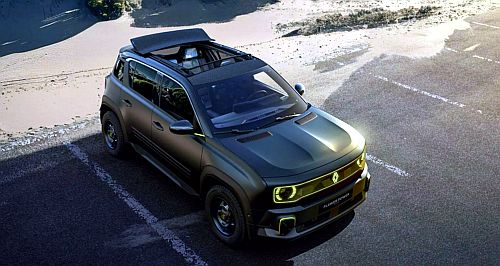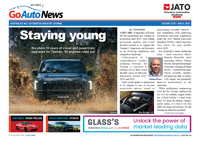Make / Model Search
Future models - RenaultNew model onslaught for Renault AustraliaRenault Australia commits to six new models over 18 months, including additional BEVs8 Aug 2025 By MATT BROGAN RENAULT Australia has announced that it will launch six new or refreshed models into local showrooms over the coming 18 months, including at least one new battery electric vehicle (BEV).
Speaking at the launch of the Renault Duster in Melbourne this week, the French importer said it plans to release a new model every three months for the next year and a half.
“The Duster is the start of a major model rejuvenation for the Renault brand here in Australia, and while I can’t go into detail today, following the Duster we will launch six new or refreshed models over the next 18 months,” explained Renault Australia general manager Glen Sealey.
“That’s an average of one every three months, or once per quarter. So, you’re going to see and hear a lot from us in the not-too-distant future.”
While Mr Sealey would not be drawn on which models would arrive – or when – he said everything in the Renault global portfolio is “on the table”, including new energy and commercial vehicle offerings, and models from within the larger Renault Group such as those from Dacia and Alpine.
“Renault has a vast portfolio – Darcia product, Renault product, and Alpine product – and we are lucky to pick and choose from that cupboard,” he explained.
“That said, there is a bit of water to pass under the bridge between now and then. Currency and regulatory changes, and (the impact of the Trump Administration’s) tariffs create a very dynamic environment which means I can’t sit here and say, ‘we will definitely have that car here tomorrow’.”
As to how those changes will impact the number of battery electric vehicles Renault Australia elects to choose from the head-office ‘cupboard’, Mr Sealey said that choice will be driven solely by consumer demand, and not necessarily by external forces such as the New Vehicle Efficiency Standard (NVES).
“In terms of electrification … we would have to say that there will be a baseline for electrification in Australia,” he added.
“Prior to NVES there was around 7.5 to 8.0 per cent of the market interested in electric vehicles, and today, post NVES, the market is still sitting at around 7.5 or 8.0 per cent.
“What we see from that – and it is something all car companies must respect – is that the consumer drives the bar, and so it will be the consumer that dictates whether electrification is adopted further or less.
“The regulatory framework that is out there is the framework that we will operate under, and as a European brand, we have a fantastic product range to operate within an environment where NVES is in play.”
Mr Sealey cautioned that while the availability of vehicles on the list for Australia was considerable, those under consideration would need not only to meet customer and regulatory demands, but to also prove profitable.
“When we look at any sort of vehicle … it has to work for the OEM, it has to work for the distribution network, and most importantly it has to work for the customer,” he emphasised.
“It has to offer the customer value, and they have got to want the vehicle.
“Renault is quite a unique brand in that we have something like the Duster, and then we have other vehicles including commercial vehicles like the Kangoo, Trafic, and Master.
“That’s what makes the brand work – it can draw on the strength of its multiple resources.”
 Read more22nd of July 2025  New flagship joins Renault Koleos rangeTechno variant to replace Intens in Koleos line-up, priced from $39,990 + ORC16th of July 2025  Renault offers driveaway pricing on MY25 MasterMaster line-up reduced to two, as Renault incentivises range with driveaway pricing offer1st of July 2025  Duster sweeps in from under $32KRenault prices its Duster SUV for Australia, two-variant range generously specifiedAll future models Alfa Romeo Alfa Romeo Abarth Abarth Audi Audi Aston Martin Aston Martin BMW BMW Bentley Bentley Chrysler Chrysler Chevrolet Chevrolet Dodge Dodge Citroen Citroen Ferrari Ferrari DS DS Ford Ford Fiat Fiat FPV FPV Foton Foton Haval Haval Great Wall Great Wall Honda Honda Holden Holden Hyundai Hyundai HSV HSV Isuzu Isuzu Infiniti Infiniti Jaguar Jaguar Iveco Iveco Kia Kia Jeep Jeep Land Rover Land Rover Lamborghini Lamborghini Maserati Maserati Lexus Lexus McLaren McLaren Mazda Mazda Mercedes-Benz Mercedes-Benz Mitsubishi Mitsubishi Mini Mini Opel Opel Nissan Nissan Porsche Porsche Peugeot Peugeot Ram Ram Proton Proton Rolls-Royce Rolls-Royce Renault Renault Skoda Skoda Saab Saab SsangYong SsangYong Smart Smart Suzuki Suzuki Subaru Subaru Toyota Toyota Tesla Tesla Volvo VolvoMotor industry news |
Click to shareRenault modelsResearch Renault All future models Alfa Romeo Alfa Romeo Abarth Abarth Audi Audi Aston Martin Aston Martin BMW BMW Bentley Bentley Chrysler Chrysler Chevrolet Chevrolet Dodge Dodge Citroen Citroen Ferrari Ferrari DS DS Ford Ford Fiat Fiat FPV FPV Foton Foton Haval Haval Great Wall Great Wall Honda Honda Holden Holden Hyundai Hyundai HSV HSV Isuzu Isuzu Infiniti Infiniti Jaguar Jaguar Iveco Iveco Kia Kia Jeep Jeep Land Rover Land Rover Lamborghini Lamborghini Maserati Maserati Lexus Lexus McLaren McLaren Mazda Mazda Mercedes-Benz Mercedes-Benz Mitsubishi Mitsubishi Mini Mini Opel Opel Nissan Nissan Porsche Porsche Peugeot Peugeot Ram Ram Proton Proton Rolls-Royce Rolls-Royce Renault Renault Skoda Skoda Saab Saab SsangYong SsangYong Smart Smart Suzuki Suzuki Subaru Subaru Toyota Toyota Tesla Tesla Volvo VolvoMotor industry news |











Facebook Twitter Instagram